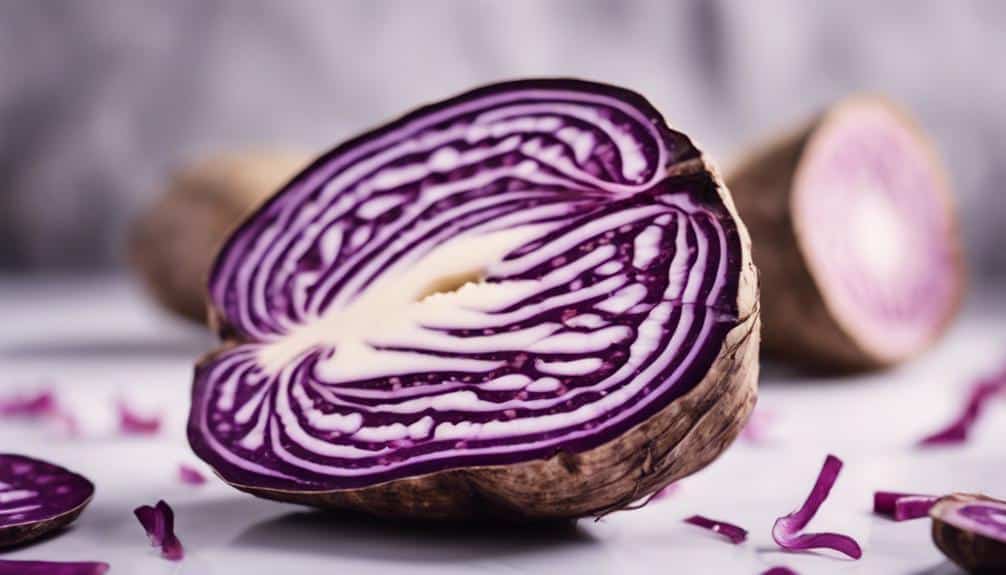Exploring the Essence of Taro Flavor

As I took my first bite of the velvety taro ice cream, a subtle yet intriguing flavor danced on my taste buds, leaving me pondering the complexity that lies within this unassuming root vegetable. The essence of taro flavor is a mysterious blend of earthiness and sweetness that has captivated culinary enthusiasts for centuries. But what truly sets taro apart from other ingredients? The answer may surprise you.
The Origin of Taro Flavor
The origin of the distinctive taro flavor can be traced back to the taro root, a starchy root vegetable renowned for its unique flavor profile. Taro, also known as Colocasia esculenta, is a staple ingredient in various cuisines worldwide, imparting a nutty and slightly sweet taste that sets it apart from other vegetables. This starchy root vegetable serves as the foundation for dishes that seek to capture its essence, providing a mild yet distinct flavor that appeals to a wide range of palates.
As a versatile ingredient, taro offers a subtle combination of vanilla and nutty undertones, making it suitable for both sweet and savory culinary creations. Its ability to enhance the taste of dishes while maintaining its own unique identity showcases the depth of flavor that taro brings to the table. Whether used in soups, stews, desserts, or snacks, the taro root's exceptional taste adds a touch of exoticism to gastronomic experiences, appealing to those with a penchant for diverse and intriguing flavors.
Nutritional Benefits of Taro
Taro, a nutrient-dense root vegetable, offers a plethora of health benefits. Its rich fiber, vitamin, and mineral content, such as potassium, vitamin E, and B vitamins, make it a valuable addition to a balanced diet.
Consuming taro can promote heart health, aid digestion, and boost immunity, highlighting its significance in supporting overall well-being.
Health Benefits Overview
Incorporating this root vegetable into meals can greatly enhance the nutritional value of one's diet. Taro is a powerhouse of fiber, vitamins, and minerals, offering a wholesome option for a well-rounded diet.
Its rich potassium content supports heart health and helps in maintaining ideal blood pressure levels. Additionally, taro is packed with antioxidants that protect cells from damage and aid in reducing inflammation within the body.
Being naturally gluten-free, taro is a safe choice for individuals with gluten sensitivities or celiac disease. Its complex carbohydrates provide sustained energy, promoting overall health and well-being.
Adding taro to your meals not only elevates flavor but also contributes significantly to your nutritional intake.
Taro Nutrient Profile
With a robust nutritional profile comprising fiber, potassium, and vitamin E, taro stands out as a versatile root vegetable offering numerous health benefits. Taro is rich in complex carbohydrates, essential minerals like manganese and magnesium, and antioxidants such as beta-carotene, lutein, and zeaxanthin. These nutrients support various bodily functions including digestive health, heart function, sustained energy levels, and immune function. A 100g serving of taro provides approximately 112 calories, making it a relatively low-calorie option. The presence of phosphorus in taro contributes to overall well-being. Below is a breakdown of the key nutrients found in taro:
| Nutrient | Functionality | Benefits |
|---|---|---|
| Fiber | Digestive health | Supports healthy digestion |
| Potassium | Heart function | Helps regulate blood pressure |
| Vitamin E | Antioxidant | Protects cells from damage |
| Manganese | Metabolism | Supports bone health |
| Magnesium | Muscle function | Aids in muscle and nerve function |
Dietary Advantages of Taro
A substantial source of dietary fiber and essential nutrients, taro offers valuable health benefits for overall well-being. Taro is rich in fiber, aiding in digestion and promoting gut health.
Additionally, taro provides a good dose of vitamins and minerals such as vitamin E, potassium, and magnesium. Being low in fat and cholesterol, taro is a heart-healthy food choice.
Its carbohydrate content also offers sustained energy, making it a great source of fuel. Moreover, taro contains antioxidant properties that help protect cells from damage and boost overall health.
Including taro in your diet can contribute to a well-rounded nutritional intake, supporting various aspects of health and providing essential nutrients for optimal functioning.
Taro Flavor in Culinary Traditions
Taro flavor emerges prominently in diverse culinary traditions worldwide, showcasing its versatility and distinct taste profile. Taro, with its mild, slightly sweet taste and nutty vanilla notes, is a staple in global cuisines, including African, Asian, and Australian dishes. Its unique flavor profile complements a wide range of recipes, from soups to fritters and dumplings, making it a beloved root vegetable in culinary traditions. In traditional Polynesian dish poi, taro, known as 'bread' in Maori, plays a significant role. With over 100 varieties globally, taro offers a distinct taste experience that adds depth to various dishes.
| Culinary Tradition | Taro Utilization |
|---|---|
| African Dishes | Taro used in stews and porridges |
| Asian Cuisine | Taro featured in desserts like taro bubble tea |
| Australian Recipes | Taro incorporated in savory pies and casseroles |
| Polynesian Delicacies | Taro essential in dishes like poi and taro coconut milk |
| Global Fusion Dishes | Taro employed in innovative dishes blending traditions |
Taro Flavor Pairings

Taro's flavor profile lends itself well to a variety of pairings, enhancing both sweet and savory dishes. Its tropical essence shines when paired with coconut, while its earthy notes balance out the flavors in savory dishes like curries.
The versatility of taro allows it to harmonize with a range of ingredients, from matcha to mango, offering a diverse and delightful culinary experience.
Taro's Unique Complements
Enhancing dishes with its unique flavor profile, taro finds ideal complements in a diverse range of ingredients. Taro's creamy texture harmonizes perfectly with coconut milk, offering a tropical flair to various culinary creations.
When paired with savory elements like pork, taro's mild sweetness contributes to a well-rounded and flavorful dish. The nutty undertones of taro create a delightful contrast with tangy fruits such as mango, resulting in a balanced sweet and tart fusion.
In desserts, taro blends seamlessly with chocolate, producing a decadent treat that tantalizes the taste buds. Additionally, the earthy notes of taro pair exquisitely with spices like cinnamon and cardamom, infusing dishes with warm and aromatic nuances.
Taro's versatility truly shines when combined with these complementary ingredients.
Perfect Taro Matches
When considering ideal flavor pairings, the essence of taro emerges as a versatile ingredient that seamlessly integrates with a range of complementary flavors. Taro's earthy sweetness pairs exquisitely with the creamy tropical notes of coconut, creating a harmonious blend that delights the palate.
In desserts, taro adds a unique twist to classics like mochi and cheesecake, elevating them with its distinctive flavor profile. Additionally, taro's nutty undertones create a delightful contrast with matcha, making it a perfect match for beverages and desserts.
For a rejuvenating combination, taro's earthy sweetness beautifully contrasts with tangy fruits like mango, offering a balanced and invigorating experience. Taro's versatility shines when paired with rich chocolate, imparting depth and complexity to sweet creations.
Taro Flavor in Global Cuisine
Indispensable across diverse culinary landscapes, taro's distinctive flavor adds a unique dimension to global cuisines. Taro is a fundamental ingredient in various culinary traditions worldwide, with significant representation in Africa, Asia, and Australia. Its importance is exemplified by the Maori translation of taro as bread, emphasizing its vital role in different cultures.
In Polynesian cuisine, taro holds a central place, featuring prominently in dishes such as poi. Nigeria stands out as the top global producer of taro, with around 18 million tons harvested annually. Taro's versatility shines through in a multitude of dishes like fritters, spring rolls, and dumplings, demonstrating its adaptability across different culinary practices.
The ability of taro to complement and enhance flavors in global cuisines highlights its widespread appeal and enduring presence in the culinary world.
Taro Flavor in Beverages

Taro flavor's versatility extends beyond traditional dishes into the domain of beverages, offering a unique blend of sweetness and nuttiness that captivates taste buds worldwide. Taro-infused drinks such as bubble tea and milk tea not only deliver this distinctive flavor profile but also boast a visually appealing purple hue, making them a popular choice among beverage enthusiasts. The creamy and velvety texture of taro pairs harmoniously with sweetened condensed milk, resulting in a luscious and indulgent beverage experience that's both satisfying and memorable.
This flavor, often likened to a combination of vanilla and cookies and cream, has gained global popularity, attracting tea lovers seeking a new and exciting taste sensation. The incorporation of taro in beverages hasn't only inspired creative dessert concoctions but has also established itself as a sought-after flavor in the culinary landscape. With its sweet yet nutty notes, taro continues to charm palates and elevate the drinking experience, solidifying its place as a beloved flavor choice in the beverage world.
Taro Flavor in Desserts
With its versatile nature and distinct flavor profile, desserts infused with taro offer a delightful blend of nutty and slightly sweet notes, elevating the overall taste experience to new heights.
Taro's creamy texture adds a velvety richness to desserts, creating a luxurious mouthfeel that enhances the indulgence factor. The slightly sweet undertones of taro complement various dessert ingredients, balancing out the overall sweetness and adding a unique depth of flavor.
Taro's earthy essence shines through in desserts like taro ice cream, taro cake, and taro mochi, showcasing its adaptability across different culinary creations. This root vegetable's popularity in desserts extends globally, with Asian countries such as Taiwan, Japan, and the Philippines incorporating taro into traditional sweet treats.
The widespread appreciation for taro in desserts underscores its ability to infuse a distinct and delightful flavor profile into a wide array of confections, making it a sought-after ingredient for those seeking a touch of innovation in their sweet creations.
Conclusion
To sum up, the essence of taro flavor is characterized by its nutty and slightly sweet notes, making it a versatile ingredient that enhances the overall taste profile of various dishes.
Beyond its delicious taste, taro also offers valuable nutrients, making it a beneficial addition to a balanced diet.
Whether enjoyed in savory dishes, beverages, or desserts, taro brings a unique and comforting essence that adds depth and richness to culinary creations worldwide.





